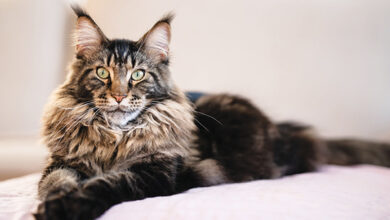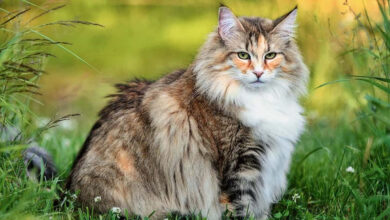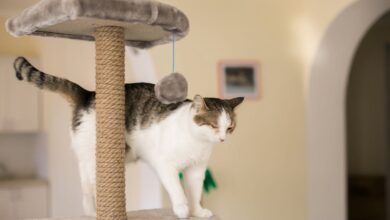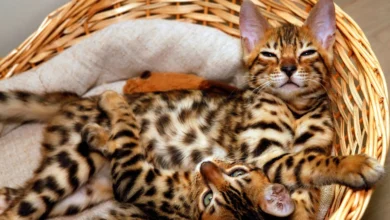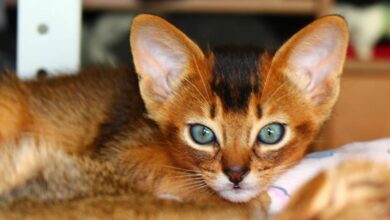Colours, Traits, and Care for These Colourful Feline Friends: Calico Cats
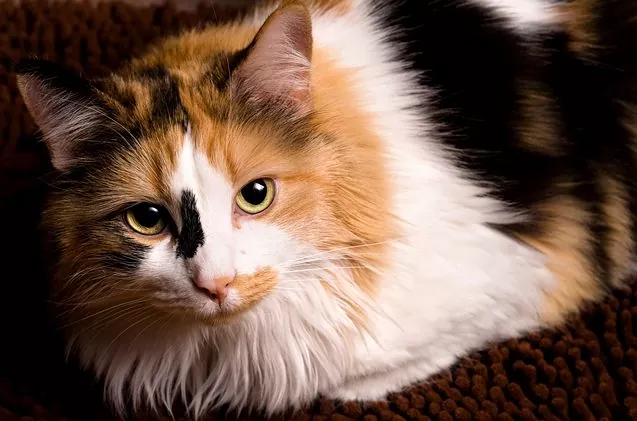
FAQ about Calico Cats
Are Calico cats autistic?
There is no scientific evidence that calico cats are more prone to autism or display autistic-like behaviors. However, some owners may attribute certain unique cat traits to “autistic” based behaviors. It’s important to remember that all cats have their own personalities, and traits such as independence and curiosity are normal for many felines, not just calicos.
Some key things to note about this topic:
- Autism is a neurodevelopmental condition diagnosed in humans based on social and communication challenges. It has no equivalent animal diagnosis.
- Calicos are recognized for active, inquisitive personalities but show normal social interaction skills with other animals and people.
- Calling any pet “autistic” risks further perpetuating misunderstandings about what autism is in humans too.
- All cats can vary individually in behaviors based on early life experiences, too, not just their fur pattern.
- Calicos simply tend to stand out due to their interesting coats alongside energetic spirits but share the typical diversity seen across domestic cat personalities.
While calicos may attract more attention for their looks and lively natures, there is no proof they exhibit any increased likelihood of behaviors resembling the features of autism in humans. Their traits are well within normal diversity for the species.
Why is a calico cat usually female?
As described earlier, the genetic mechanism behind a calico cat’s patching requires a feline to express two different coat color genes on their X chromosomes – one for black/grey hairs and another for orange/ginger hairs. To break this down even further:
- Female cats are XX, with two X chromosomes in each cell. One X chromosome randomly becomes inactive in each cell via a process called Lyonization. This gives each cell a mixture of colors controlled by genes on the active and inactive X.
- Male cats are XY, with only one X chromosome. They can only express one coat color gene per cell rather than two different genes, so male cats cannot become calico.
However, in very rare cases, estimated at around 1 in 3000 males, a genetic condition called Klinefelter syndrome can occur. This is when a male cat is XXY rather than XY due to a random extra X during conception. In these exceptional cases, calico coloring may sometimes be present.
While calico coats require the expression of two coat color genes, female cats normally fulfill this via random X-inactivation between their two X chromosomes. This is why calico coloring is typically a feature of the female domestic cat genome.
How rare is a calico cat?
Statistics on calico cat birth rates show they are not exceptionally rare, occurring in around 1 in 5 domestic cat litter where the mother carries the genetics to pass on tortoiseshell/calico coloring to her kittens.
Specifically:
- For litters where the mother is a calico or tortoiseshell herself, approximately 20% of female kittens born can be expected to display the calico/tortoiseshell patching.
- Of the overall random-bred domestic cat population, including pedigrees and moggies, around 1 in 5 cats born are estimated to be female calico or tortoiseshell coated.
- In contrast, male calico cats are genuinely rare. Research suggests that only around one male calico is born for approximately 3000-5000 male kittens on average.
So, while not common per se, calico coloring itself amongst female felines is certainly not a hugely infrequent genetic occurrence either. It’s the male calico (around 0.02% of males) that would be classified scientifically as truly rare. Calicos themselves remain a popular companion variety though not especially exotic.
Can a female calico cat get pregnant?
Absolutely, female calico cats are fully fertile and able to successfully get pregnant and carry litters to term like any normal domestic feline. Their distinctive fur pattern has no influence over their reproductive physiology or capacity in any way.
Some more details on this:
- Calico queens come into heat and can mate with male cats completely normally during their fertile periods.
- The genes that cause their tortoiseshell/calico coloring are found on the X chromosome and do not impact other aspects of female cat reproductive development.
- Pregnancy, whelping (giving birth), lactation, and mothering abilities are all unhindered in calico queens.
- Calico cats can even pass on their coloring genetics, so some kittens born to a calico mother may be calico/tortoiseshell coated themselves. However, the father determines if any calico sons are possible.
In essence, a cat having calico fur does not impact fertility or ability to breed whatsoever. Their unique coat is simply a cosmetic genetic trait unrelated to reproduction.
Is my cat a calico or a tabby?
Telling whether a multi-colored cat is a calico versus a tabby can sometimes require a close inspection of their coat’s pattern:
- Calico coats have random patches of color, not in stripes or spots. The black/grey, ginger/orange, and white sections show no repeating pattern.
- Tabby coats integrate stripes, swirls, or spotting patterns within their colored (usually ginger/tawny and black/grey) areas. The patches follow a trademarked pattern.
- Some cats are tabby calicos, and they display tabby striped/spotted patches within the randomly placed sections of their calico tortoiseshell patching.
- Taking a close-up photo can help a vet examine if any striping is perceptible within the patches.
- Behavior and personality do not determine the type of fur.
- Genetic DNA testing is an option if the difference remains unclear by visual inspection.
Calico cat breed
Calico cats are one of the most well-known cat coat patterns. Their coats feature a mixture of black, grey, and ginger/orange patches in no particular pattern or order. This coloring is due to the random X-chromosome inactivation that occurs in female cats.
Calicos are almost always female, as the genetic factors behind their coat colors require them to have two X chromosomes. Males rarely display calico coloring due to genetic reasons we will explore later.
Genetically, calico cats are referred to as tricolor cats. They belong to the domestic cat breed and have no distinctive breed standards. However, their beautiful patchwork coats make them one of the most popular pet cat varieties kept across Australia and worldwide.
Calico cat male and female
The genetic mechanism behind a cat’s tricolor coat involves the X chromosome. Female cats have two X chromosomes (XX), while male cats have one X and one Y chromosome (XY).
- In females, one of the two X chromosomes in each cell is randomly inactivated in a process called X-inactivation. This gives each cell a mix of orange/ginger and black coat colors controlled by genes on the active and inactive X chromosomes.
- Males only have one X chromosome, so they can only express one coat color gene and not display the calico patching. Exceptionally rare genetic abnormalities can result in male calicos, but these are still uncommon.
So, in summary – the calico coat pattern requires a cat to have two different coat color genes actively expressed in each cell. This is only possible in female cats due to X-chromosome inactivation.
Calico cat price
Calico cats are not a pedigree breed and can be adopted from animal shelters or purchased from hobbyist breeders. Their calico coloring alone does not affect their price. Other factors like age, health, temperament, and source will influence typical costs:
- Shelter adoption fees range from $30-80 on average for adult calico cats. Younger kittens may be slightly more.
- From hobbyist breeders expecting calico litters, kittens usually range from $100-300 depending on the breeder’s reputation, location, and additional traits.
- Rare ‘tuxedo’ or pointed calicos (with white patches) may be priced higher, around $300-500, due to their unusual colors.
Overall calico cats are very affordable pets. Prioritise adoption to save a cat in need rather than buying from breeders when possible. Remember veterinary care, food, litter, etc, will be ongoing costs too.
Female calico cat personality
On average, female calico cats tend to have striking personalities that match their striking coats! Here are some common traits seen:
- Affectionate nature – Calicos love human company and attention. Many enjoy sitting in laps and receiving pats.
- Playful spirit – Calicos retain a kitten-like energy and enjoy toys, interactive play, and chasing laser pointers well into adulthood.
- Observant intelligence – Their multi-colored coats seem linked to keen problem-solving skills and quick learning. Calicos pick up how to operate pet doors, cabinets, and more with ease.
- Independent streak – While loving company, calicos also relish time alone to rest, explore, or sunbathe without interference. Respect their need for both interaction and independence.
- Vocal communicators – Calicos find clever ways like meowing, chirping, or trilling to make their thoughts and needs very clearly known!
Of course, individual personality varies and is shaped by early life experiences too. But these traits provide a lighthearted overview of a typical calico companion.
Tabby calico cat
Some calico cats also carry the tabby genetics responsible for distinctive striped or spotted patch patterns within their colored areas. This creates an even rarer fur pattern called a ‘tabby calico.’
Genetically tabbies have alleles for agouti signaling protein (ASIP gene) that control the distribution of darker hairs within the light and dark areas of the coat. When combined with tortoiseshell/calico X-inactivation, it leads to beautifully complex patched coats.
The tabby markings add visual interest to the ginger, black, and white patches. However, it does not influence the cat’s temperament or care needs compared to a standard calico. Tabby calicos are just as wonderful, whimsical pets!
Health problems with calico cats
Overall, calico cats have similar life expectancies and health risk factors to domestic short/longhaired cats. However, a few potential concerns can be:
- Hypertrophic cardiomyopathy – A genetic heart condition sometimes seen in certain cat breeds. More research is needed on calico genetics and risk levels. Monitor for symptoms and see a vet for screening if in a high-risk family line.
- Gingivostomatitis – A common inflammatory mouth disease in cats prone to gum problems. Calicos may be slightly more at risk. Manage with good dental hygiene, diet, and early vet visits if gums appear inflamed.
- Inherited diseases – Like any cats, calicos raised by carriers of genetic issues have a small chance of traits for familiar spinal muscular atrophy, PK deficiency, or other rarer conditions depending on family history. Screen parents if concerned.
With proper care and preventative veterinary checks, calico cats can live long, happy, and healthy lives indoors. Monitor for any concerning symptoms but don’t assume they will automatically have issues based on colouring alone. Good owner care is key.
The best approach, if unsure, is to discuss it with your vet. Sometimes the distinction is subtle, but getting clarity helps in understanding your individual cat and any potential breed quirks. Proper identification confirms the specific fur genetics involved.
